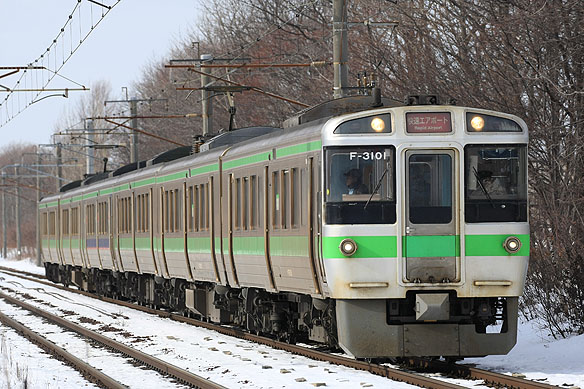Background and overview
In March 2002, Eniwa Station was added to the stop pattern of the "Airport"
rapid services linking Otaru and Shin-Chitose Airport. To maintain the
existing journey time between Sapporo and Shin-Chitose despite the additional
stop, JR Hokkaido introduced 130 km/h operation. As part of this initiative,
three 6-car sets of the 721-100 series were modified between June 2001
and February 2002 to support higher-speed operation and were reclassified
as the 721-3100 series.
Car body
To improve durability and winter resistance, the side windowpanes were
replaced with polycarbonate panels. Headlights located below the windscreens
were upgraded to high-intensity discharge (HID) lamps.
Bogies
Yaw dampers were replaced from type YA40 to OD65A-1. Brake lever ratios were adjusted to improve braking performance: powered vehicles from 10.08 to 8.31, trailer vehicles from 8.05 to 6.15. Brake cylinder diameters were increased from 140 mm to 160 mm.
Traction unit and ancillary equipments
The brake cylinder pressure control pattern of the electric-command brake
system was revised. The vehicle information and control display were upgraded
from a plasma display to an LCD-based human-machine interface (HMI). Automatic
announcement equipment was newly installed.
Modifications
Expansion of U-Seat Accommodation
Between November 2023 and February 2024, Saha721-3201 to -3203 were modified
to expand "U-seat" reserved seating across the entire passenger
compartment. The high-level floor was removed, and the exterior was updated
with a blue waistline band, a red accent stripe below the windows, and
vertical blue bands adjacent to the doorways.
Refurbishment Programme
Background and overview
In January 2012, JR Hokkaido refurbished three 6-car sets of the 721-3100 series to improve reliability following frequent traction system failures. The refurbishment included replacement of the traction system with a variable-frequency drive and structural upgrades to the carbody.
As part of the conversion:
- Kumoha721-3200 vehicles were reconfigured into trailer-end cars Kuha721-3200.
- Moha720-3100 vehicles were converted into trailer intermediate cars Saha721-3100.
- The resulting formation consists of two powered vehicles and four trailer vehicles.
Car body
Corroded floor panels, aged floor sheets, and thermal insulation were replaced.
Moha721-3200 and Kuha721-3100 class vehicles were fitted with 1 mm-thick
stainless-steel cover plates between underfloor equipment to reduce surface
undulation and prevent snow and ice accumulation. Anti-fall plates were
installed between vehicles, excluding the cab ends.
Bogies
Motored bogies are N-DT721. Kuha721-3100 and Saha721-3200 are fitted with
N-TR721 trailer bogies, while Kuha721-3200 and Saha721-3100 employ N-DT721T
bogies converted from motored bogies previously carried by Kumoha721-3200
and Moha720-3100. All bogies feature bolster-less secondary air suspension,
conical multilayer rubber spring journal supports, and a Watts linkage
draw gear. Power transmission utilizes Twin Disc (TD) flexible joints with
carbon-fiber reinforced plastic (CFRP) deflecting plates. The gear ratio
was changed to 5.19 to enhance acceleration performance at medium to high
speeds, with a maximum service speed of 130 km/h. All bogies employ double-tread
brake rigging with enhanced-adhesion alloy cast iron brake shoes.
Traction unit and ancillary equipments
Moha721-3100 and Moha721-3200 are equipped with traction system N-CI721-1, controlling four AC induction motors (N-MT721A), each rated at 230 kW per truck. The system comprises a three-level PWM converter and a two-level variable-frequency drive (VFD), both employing insulated gate bipolar transistors (IGBTs). The original traction resistor units for rheostatic braking were removed.
A travelling wind self-cooled traction transformer (N-TM721A-AN) is mounted
beneath the floor. Air compressors on Kuha721-3200 and Saha721-3100 were
replaced with N-MH1045-C2000ML units, and auxiliary power supplies were
upgraded to N-APS721C, rated at 8 kVA. The braking system is an electric-command
type featuring regenerative and holding brake functions, with control logic
prioritizing trailer vehicles.
Operations
The 721-3100 series entered service on "Airport" rapid services
in 2002, operating between Otaru and Shin-Chitose Airport. In addition
to express duties, these units are also assigned to regional services on
the Sapporo, Chitose, and Sassho Lines. |
|
| Technical Data |
| Items |
Data |
| Supply Voltage |
20,000 V AC, 50 Hz |
| Service speed,
etc. |
Acceleration: 2.4 km/h/s Deceleration: 4.1 km/h/s Service speed: 130 km/h |
| Length |
20,800 mm |
| Width |
2,954 mm |
| Height |
3,670 mm |
| Bogie |
N-DT721 (powered) N-TR721 (trailer) |
| Collector |
N-PS785 |
| Traction
motor |
N-MT721A (250 kW) |
| Gear ratio |
5.19 |
| Transformer |
N-TM721A-AN |
| Rectifier |
N-CI721-1 |
| Traction system |
Converter and variable frequency drive on truck basis: N-CI721-1 |
| Air conditioner |
N-AU721 (20,000 kcal/h×1) |
| Designed
by |
JR Hokkaido |
|
|

